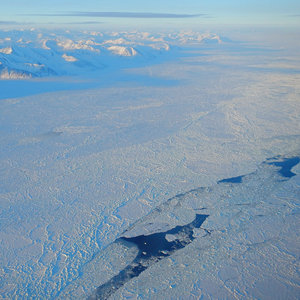CPOM scientists have found that Arctic sea ice volume increased markedly in the summer of 2013 compared to the previous three years, as less of the ice melted due to lower air temperatures.
The research, published in Nature Geoscience, suggests that the ice is more sensitive to changes in summer melting than it is to winter cooling, an important finding which will influence predictions of its future change.

Thick, heavily deformed multi-year sea ice in the Lincoln Sea, off the north coast of Greenland, 29th March 2014 (Credit: Tom Armitage)
The team used measurements from the European Space Agency’s CryoSat-2 mission, which was designed especially to detect changes in sea ice volume. Although there was a 14% reduction in summertime Arctic sea ice volume between 2010 and 2012, this was followed in 2013 by a 33% increase compared to previous levels.
Lead author and CPOM researcher at University College London (UCL) Rachel Tilling explained: “Until 2013, the volume of Arctic sea ice was going down, but in 2013 there was a sharp increase, we think because that summer was much cooler than recent years.”
The lower summer temperature in 2013 – conditions more typical of the late 1990s – allowed thick sea ice to persist northwest of Greenland, because there were fewer days when it could melt.
Rachel added: “Although models have suggested that Arctic sea ice volume is in long term decline, we know now that it can recover by a significant amount if the melting season is cut short.”
Arctic sea ice extent has been steadily falling since the late 1970s. However, until now it has been difficult to assess how the volume has changed, because the ice pack drifts, and because there have historically been very few sea ice thickness measurements from across the region.
To detect changes in Arctic sea ice volume, the team combined 88 million measurements of sea ice thickness recorded by CryoSat-2 since it was launched in April 2010 with maps of its changing extent.
Rachel explained:
“Maps of sea ice extent have been extremely useful, but our measurements of its thickness now complete the picture, because they reveal what’s going on below the water – where most of the action happens.”
Although the first five years of CryoSat-2 measurements have revealed important information on the state of Arctic sea ice, the record is still too short to establish a long-term trend. Nevertheless, understanding what controls the amount of sea ice puts us one step closer to making reliable predictions of how long it will last.
CPOM Director and co-author Andy Shepherd explained:
“What’s clear, from the CryoSat-2 measurements, is that the volume of Arctic sea ice is more sensitive to summer melting than it is to winter cooling. Since we expect temperatures to rise in the future, I suspect that the events of 2013 have simply wound the clock back a few years on the long-term pattern of decline.”
Professor Shepherd added:
“Arctic sea ice is a key component of Earth’s climate system, and so we must now use CryoSat-2’s measurements to improve predictions of future climate change and, at the same time, make sure we do not lose this unique capability to monitor Arctic sea ice when the mission ends.”
The full paper is: Tilling, R.L., Ridout, A., Shepherd, A., Wingham, D.J. Increased Arctic sea ice volume after anomalously low melting in 2013, Nature Geoscience, Vol. 8, August 2015 doi:10.1038/NGEO248. Archive data of spring (March/April average) and autumn (October/November average) sea ice thickness from autumn 2010 onwards will be made available on the CPOM sea ice page.

